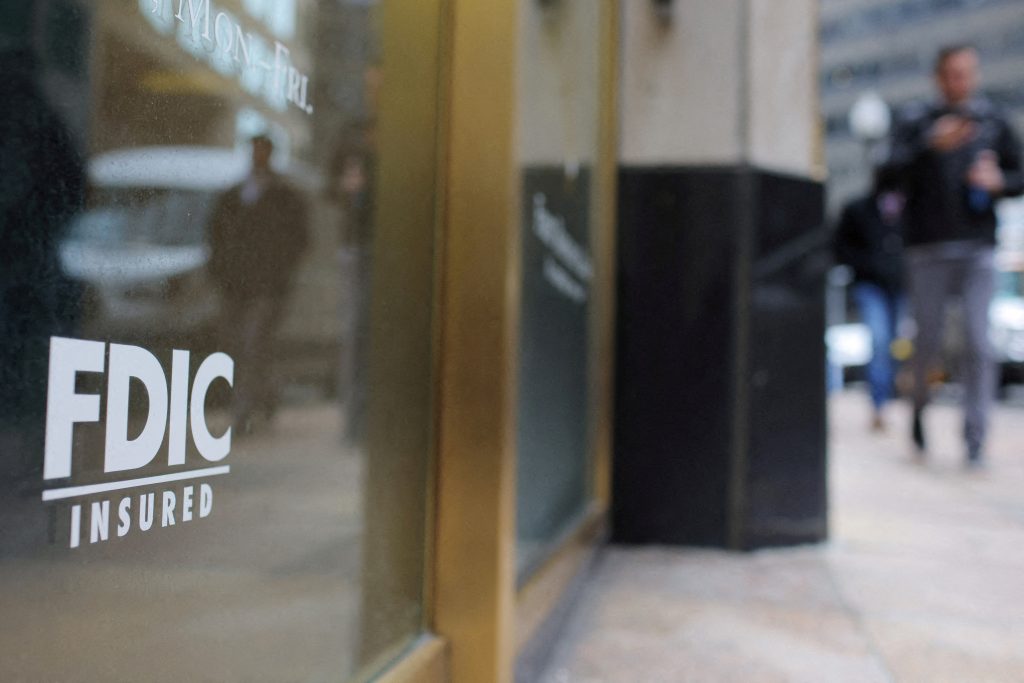 FILE PHOTO: A sign reads ?FDIC Insured? on the door of a branch of First Republic Bank in Boston, Massachusetts, U.S., March 13, 2023. REUTERS/Brian Snyder
FILE PHOTO: A sign reads ?FDIC Insured? on the door of a branch of First Republic Bank in Boston, Massachusetts, U.S., March 13, 2023. REUTERS/Brian Snyder The Federal Deposit Insurance Corp is expected to propose next month how to make the U.S. banking sector pay for an estimated $23 billion hole in its insurance fund by the collapse of Silicon Valley Bank and Signature Bank in March.
The agency has broad authority in setting the terms of what is known as a “special assessment” to fill the gap and precisely what this will look like is still an open question.
Banking trade organizations tell Reuters they have yet to hear specifics about the assessment. The FDIC declined to comment.
Here is what is known about the assessment and the insurance fund:
What is the Deposit Insurance Fund?
The Deposit Insurance Fund (DIF) is a pot of cash that the FDIC maintains to guarantee up to $250,000 of depositors’ money. As an insurance premium, banks ordinarily pay a quarterly “assessment” based on a set methodology drawing on financial data and risk determinations.
To stop the spread of panicked withdrawals throughout the banking system last month, the FDIC guaranteed all deposits at SVB and Signature Bank, even those over $250,000. Such losses require the FDIC to impose a “special assessment” to replenish the DIF.
The law does not define the “assessment base” for the special assessment or which banks will pay it. There is not a time frame for recouping the funds. Echoing the testimony of FDIC Chair Martin Gruenberg, former FDIC Chair Sheila Bair told Reuters on April 6 the agency has “a lot of latitude” in designing the special assessment.
What happened the last time?
Currently, the law requires the FDIC to maintain $1.35 in the fund for every $100 of insured deposits. By the end of December, DIF’s balance stood at $128.2 billion, meaning the bank failures in March could account for about 18% of the fund.
During the financial crisis of 2008 the sheer volume of bank failures pushed the DIF about $20 billion into the red. After a period of public comment, the FDIC’s May 2009 final rule on a special assessment put the cost burden more heavily on the shoulders of the biggest financial institutions.
In the second quarter of 2009, for example, JPMorgan Chase & Co booked a $675 million pre-tax charge for the special assessment, which it said shaved 10 cents off earnings per share. Wells Fargo reported an 8 cent per-share hit to earnings.
Who will pay the special assessment?
When the FDIC initially called for a special assessment amounting to 20 basis points of banks’ insured deposits in the aftermath of the financial crisis of 2008, small-town bankers pushed back hard, letters written at the time show.
Top officials in Washington have signaled that regulators likely won’t make the smaller banks pay for last month’s failures this time round either. This reflects a change Congress and the FDIC made after the 2008 meltdown to make larger, riskier banks contribute proportionately more to maintaining the DIF.
An industry representative who asked not to be named told Reuters that bankers were hoping the ultimate bill would be less than $23 billion after the FDIC completes sales of SVB and Signature Bank assets.
(Reuters)Inside Telecom provides you with an extensive list of content covering all aspects of the Tech industry. Keep an eye on our News section to stay informed and updated with our daily articles.